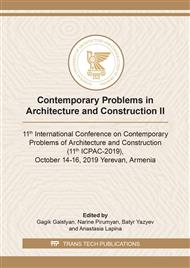[1]
Decree of the Minister of Infrastructure and Development of 17 July 2015 on the publication of a uniform text of the Regulation of the Minister of Infrastructure on technical conditions to be met by buildings and their location, Official Journal of the Republic of Poland, Dz. U. 2015:1422, (2015).
Google Scholar
[2]
A. Lis, A. Ujma, Assessment of low emission reduction after modernization of building by different variants of fuel type selecting, Construction of Optimized Energy Potential. 1(19) (2017) 121-128.
Google Scholar
[3]
A. Kralj, M. Drev, Z. Žnidaršič, B. Černe, J. Hafner, B.P. Jelle, Investigations of 6-pane glazing: Properties and possibilities, Energy & Buildings. 190 (2019) 61-68.
DOI: 10.1016/j.enbuild.2019.02.033
Google Scholar
[4]
M. Arici, H. Karabay, M.Kan, Flow and heat transfer in double, triple and quadruple pane windows, Energy and Buildings. 86 (2015) 394-402.
DOI: 10.1016/j.enbuild.2014.10.043
Google Scholar
[5]
Z. Respondek, Influence of insulated glass units thickness and weight reduction on their functional properties, Open Engineering. 8 (2018) 455–462.
DOI: 10.1515/eng-2018-0056
Google Scholar
[6]
L. Śliwowski, A Building and Its Physical Environment, Mon. 28, Wroclaw University of Technology Publisher, Wrocław, (1992).
Google Scholar
[7]
D.G. Andrews, An Introduction to Atmospheric Physics, second ed., Cambridge University Press, Cambridge UK, (2010).
Google Scholar
[8]
L. Adelard, F. Pignolet-Tardan, T. Mara, P. Lauret, F. Garde, H.Boyer, Sky temperature modelisation and applications in building simulation, Renewable Energy. 15 (1998) 418-430.
DOI: 10.1016/s0960-1481(98)00198-0
Google Scholar
[9]
Z. Respondek, Effect of radiative cooling on heat transfer through building partitions, IOP Conference Series: Earth and Environmental Science. 214 (2019) 1-10.
DOI: 10.1088/1755-1315/214/1/012004
Google Scholar
[10]
PN-EN 673:2011 Glass in building - Determination of thermal transmittance (U value) - Calculation method.
Google Scholar
[11]
A.A. Solovyev, S.V. Rabotkin, N.F. Kovsharov, Polymer films with multilayer low-E coatings, Materials Science in Semiconductor Processing. 38 (2015) 373–380.
DOI: 10.1016/j.mssp.2015.02.051
Google Scholar
[12]
PN- EN ISO 6946:2008 Building components and building elements - Thermal resistance and thermal transmittance - Calculation method.
DOI: 10.3403/00942964
Google Scholar
[13]
M. Zeyghami, D.Y. Goswami, E. Stefanakos, A review of clear sky radiative cooling developments and applications in renewable power systems and passive building cooling, Solar Energy Materials and Solar Cells. 178 (2018) 115-128.
DOI: 10.1016/j.solmat.2018.01.015
Google Scholar
[14]
D. Sato, N. Yamad, Review of photovoltaic module cooling methods and performance evaluation of the radiative cooling method, Renewable and Sustainable Energy Reviews. 104 (2019) 151-166.
DOI: 10.1016/j.rser.2018.12.051
Google Scholar
[15]
B. Zhao, X. Ao, N. Chen, Q. Xuan, M. Hu, G. Pei, General strategy of passive sub-ambient daytime radiative cooling, Solar Energy Materials and Solar Cells. 199 (2019) 108-113.
DOI: 10.1016/j.solmat.2019.04.028
Google Scholar
[16]
H. Nowak, The influence of thermal radiation of the external environment on buildings, Mon. 31, Wroclaw University of Technology Publisher, Wrocław, (1999).
Google Scholar


